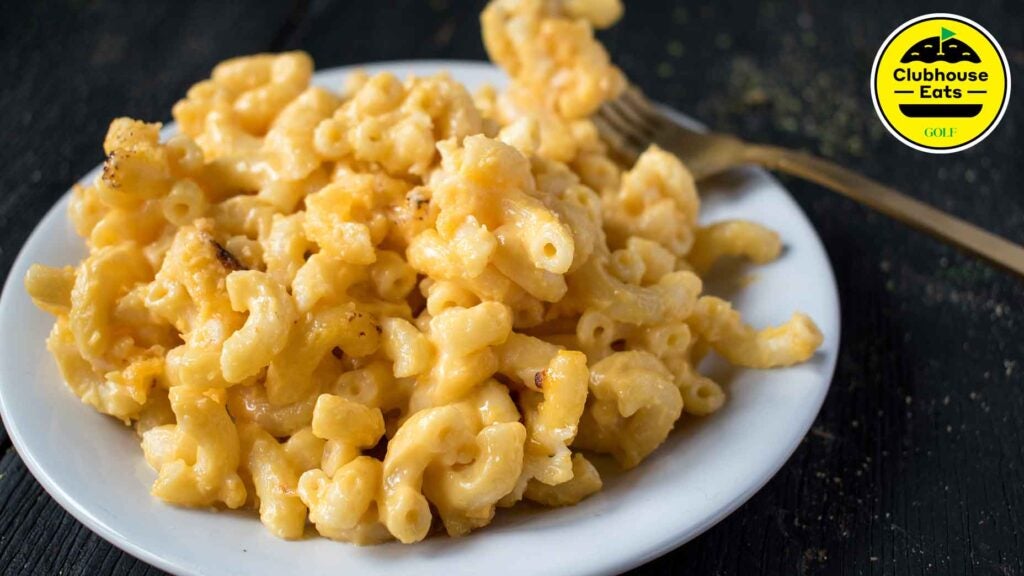As the Fourth of July and a season of cookouts is just around the corner, now’s the perfect time to dive into one of the most popular and universally satisfying side dishes: mac and cheese.
Widely considered to be the ultimate comfort food, mac and cheese is one of those concoctions that some people would say can’t possibly be bad. Even a lousy pot of mac and cheese, they’ll argue, is still pretty good.
We wholeheartedly disagree. One of life’s great culinary disappointments involves taking a bite of what looks to be a stellar rendition of the dish, only to find the cheesy pasta is bland, overcooked, or off-putting in its texture. The ultimate tragedy? It’s all of those things.
Fortunately, such regrettable miscues are easily avoided, and with guidance from Chris Ferrier, the executive chef at Lansdowne Resort (and someone who harbors a healthy fanaticism for mac and cheese), we’re here to lead you down a path toward delectable, cheesy-pasta bliss. (We’ve shared his three-cheese recipe below.)
It probably goes without saying, but the most important ingredient is the cheese. That said, not any cheese will do. Ferrier prefers whole milk cheeses, like New School American and Comté, an unpasteurized cheese from eastern France, which is his favorite. “Creamy and gooey cheeses that melt well are the best,” he advises. “And you must grate them by hand. Never use store-bought [grated] cheese that has been processed with anti-caking agents.”
Chef Ferrier also advocates blending together cheeses with different flavors, such as those that are creamy and nutty with others that have earthy tones, like Taleggio, which is not only earthy but pungent, too. Just make sure the cheeses you select aren’t oily or blended with oil. “That makes the finished product greasy,” he says.
As for the pasta, Ferrier stresses the importance of shape: tubular designs or pastas with holes or ridges are key, as those textured areas will allow the cheese sauce to stick better. Cavatappi, ditalini, and elbow-shaped macaroni work best. Also, stick with dried pastas. “Dried is firmer and better withstands being boiled, mixed into a béchamel cheese sauce, and then cooked again,” says the chef. “Just be careful not to overcook the pasta. Al dente is best. Remember, it will be baked in the oven at the end.”
Don’t veer away from rich, indulgent ingredients, either. When it comes to selecting the butter and the milk, Chef Ferrier insists on using whole-fat examples. He also likes to save a small portion of the water used to cook the pasta and adds that to the cheese sauce. “That little bit of starchy water can help as a binder,” he explains.
Finally, for those who wish to elevate their mac and cheese with gourmet toppings, Ferrier points to lobster, andouille sausage, Chesapeake crab meat, asparagus, or truffles as ideal enhancements. Just make sure that any meats or vegetables (except for truffles) are blanched or pre-cooked.
“Adding ingredients or toppings is no different than when you’re making an omelet or scrambled eggs,” he explains. “Add any you want, just make sure they can bind to the pasta and the cheese sauce.”
Macaroni and Three Cheeses
Ingredients:
– 1 lb. elbow macaroni
– 5 cups whole milk
– 9 tbsp unsalted butter, divided
– 1 small onion or shallot, finely chopped or minced
– 2 garlic cloves, finely chopped or minced
– 3/4 cup all-purpose flour
– 2 tbsp Dijon mustard
– 1 tsp Worcestershire sauce
– 2 tsp kosher salt
– 1/2 tsp freshly ground black pepper
– 3 cups cheddar cheese, shredded
– 1 cup Comté, shredded
– 1 1/2 cups freshly grated Parmesan Reggiano cheese, divided
– 3/4 cup fine plain breadcrumbs, preferably homemade
Preparation:
– Preheat the oven to 350 degrees F.
– In a large pot of boiling salted water, cook the macaroni until barely al dente, about 6 minutes. Drain and return to the pot.
– In a large saucepan over moderately high heat, melt one tablespoon of butter, then add the shallot and garlic, cooking until softened (about 5 minutes). Add the milk and bring to a simmer.
– In another large saucepan, melt six tablespoons of butter over medium heat, then add the flour and cook, stirring constantly, until lightly golden (about 5 minutes). Remove from the heat.
– Gradually whisk the simmering milk into the flour-and-butter mixture until smooth. Bring the sauce to a simmer and cook over low heat, whisking, until thick and bubbling (about 7 minutes).
– Stir in the mustard, Worcestershire sauce, salt, and pepper. Add the cheddar, Comté and 3/4 cup of Parmesan and cook over low heat, stirring, until just melted.
– Add the cheese sauce to the pot of macaroni and stir until well combined. Then transfer to a 3-quart baking dish.
– In a medium skillet over low heat, melt the remaining two tablespoons of butter, then add the breadcrumbs and cook, stirring constantly, until coated. Transfer to a bowl and stir in the remaining 3/4 cup of Parmesan.
– Sprinkle the crumbs over the macaroni, then bake until lightly golden and bubbling (about 25 minutes).
– Remove the baking dish from the oven and preheat the broiler.
– When the broiler is hot, brown the macaroni under the broiler for 10 to 15 seconds, being careful not to scorch the breadcrumbs.
– Remove the dish from the oven and let it stand for 15 minutes before serving.
